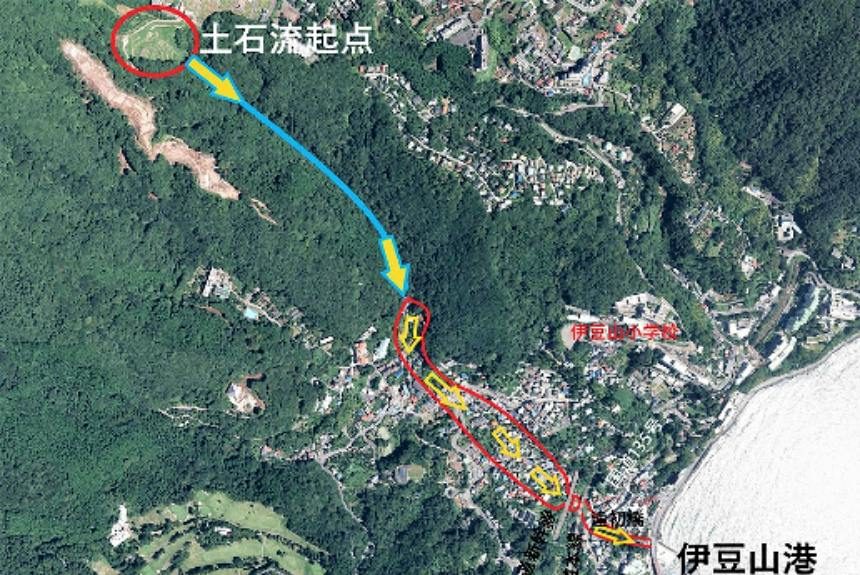The landslide that occurred in Atami, Japan, on a Saturday morning, 3rd July 2021, affected 300 homes, killed two people and left 20 others missing. Hundreds of rescuers began looking for survivors.
The BBC reports that Atami City experienced more rainfall in the first few days of July than it usually does for the whole month.
Governor Heita Kawakatsu told reporters, “Because of the heavy rain, the ground loosened, and the mudslide occurred…it picked up speed and swept away houses together with people” (At least two, 2021).
As more rain is forecasted in the next few days, and with additional warnings for further flooding in low-lying areas and sediment-related disasters, the residents of Shizuoka and the neighbouring prefectures of Kanagawa and Chiba were told to evacuate.
According to the BBC article, climate change makes these extreme weather events more frequent and more destructive. Increasing rainfall events due to climate change will also raise the risk of devastating mudslides.
But Japan is no stranger to landslides and flooding, owing to its mountainous terrain. Its dense population—75% of its assets are in flood-prone areas—contributes to the risk.
Heavy floods and landslides killed at least 50 people in the Kyushu region of southwestern Japan about the same time last year. In 2018, torrential rains that caused mudslides and floods have killed more than 114 people.
According to a CNN report, a 2020 Japanese government report shows that Japan has experienced an average of 1500 landslides every year for the past ten years, almost a 50% rise compared to the previous ten years.
Japan’s Disaster Preparedness and Response
Due to its location along the circum-Pacific volcanic belt, Japan is frequently affected by earthquakes, tsunamis, flooding, and landslides.
Marc Forni, the World Bank’s Lead Disaster Risk Management Specialist, says, “Without question, Japan is the best in this area of expertise. Learning from Japan’s effective and contextualized Disaster Management System is important for all countries to see how theory is put into practice” (Sharing Japanese Expertise, 2017).
To learn about Japan’s disaster management measures, including preparedness and response and disaster risk reduction strategies, click this link: Guide to disaster management measures in Japan
In one of our blog posts, we have also featured Japan’s climate adaptation good practices by its private sector.
What causes mudslides, and can it be prevented?
Slides are caused by water, gravity, and generally a layer of clay that lets loose. Landslides usually happen when the ground is saturated by heavy rains (Holdeman, 2016).
The article “How to reduce the risk of a landslide” explains:
- Rising water tables and increasing water pressures can contribute to slope failures, causing landslips. The majority of landslides occur during or shortly after significant rainstorms.
- When water penetrates the soil, it saturates the ground and reduces friction between the top layers of soil and the harder layers of bedrock beneath.
- The top layer of soil then slides downwards, creating a landslide.
- Slopes with no vegetation cover are especially prone to erosion.
- The simplest and natural solution to prevent landslips is to plant vegetation. Plants can slow down raindrops as they fall, and their roots can hold the soil together.
There are also engineering solutions to control erosion, such as changing the slope geometry, reinforcing slope materials with chemical solutions, using piles and retaining walls, grouting rock joints and fissures to improve surface strength and reduce permeability, diverting debris pathways, rerouting the surface, and underwater drainage. However, these methods can be constrained by cost, magnitude, frequency of landslides, and the size of the population at risk (Meng, n.d.).
Source Citation:
Japan landslide: 20 people missing in Atami city. (2021, 4 July). BBC News. Retrieved from https://www.bbc.com/news/world-asia-57704967
At least two dead after heavy rains trigger landslide in Japan. (2021, July 3). Aljazeera. Retrieved from https://www.aljazeera.com/news/2021/7/3/japan-torrential-rains-unleash-landslides-20-missing-report
Wang, S., Ogura, J., & Jozuka, E. (2021, July 4). About 20 people missing and 2 dead after mudslide wipes out homes in Japan’s Atami city. CNN. Retrieved from https://edition.cnn.com/2021/07/03/asia/japan-mudslide-atami-intl-hnk/index.html
Sharing Japanese Expertise in Emergency Preparedness and Response (EP&R) Systems at National and Local levels. (2017, October 13). The World Bank. Retrieved from https://www.worldbank.org/en/news/feature/2017/10/12/sharing-japanese-expertise-in-emergency-preparedness-and-response-systems-at-national-and-local-levels
Holdeman, E. (2016, November 11). 5 Landslide Prevention Tips Plus – When to Get Out. Government Technology. Retrieved from https://www.govtech.com/em/disaster/5-landslide-prevention-tips-plus-when-to-get-out.html
How to reduce the risk of a landslide. (2019, October 15). Ancho Systems. Retrieved from https://www.anchorsystems.co.uk/how-to-reduce-the-risk-of-a-landslide/
Meng, X. (n.d.). Landslide mitigation and prevention. Britannica. Retrieved from https://www.britannica.com/science/landslide/Landslide-mitigation-and-prevention
PHOTO CREDIT: 2021 Atami debris flow disaster by Copyright © National Land Image Information (Color Aerial Photographs), Ministry of Land, Infrastructure, Transport and Tourism, Attribution, https://commons.wikimedia.org/w/index.php?curid=107274804. The photo has been cropped to fit the website requirement.



Leave a Reply